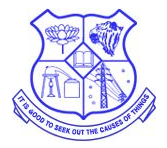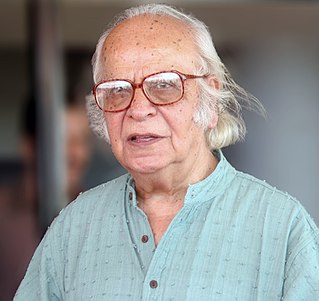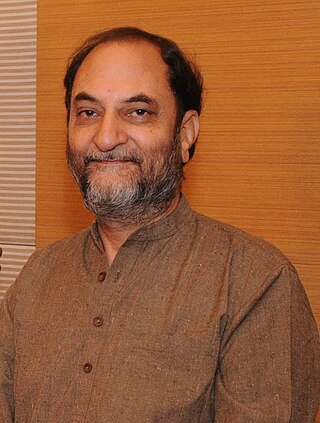Related Research Articles

Homi Jehangir Bhabha, FNI, FASc, FRS, Hon.FRSE was an Indian nuclear physicist who is widely credited as the "father of the Indian nuclear programme". He was the founding director and professor of physics at the Tata Institute of Fundamental Research (TIFR), as well as the founding director of the Atomic Energy Establishment, Trombay (AEET) which was renamed the Bhabha Atomic Research Centre in his honour. TIFR and AEET served as the cornerstone of the Indian nuclear energy and weapons programme. He was the first chairman of the Indian Atomic Energy Commission and secretary of the Department of Atomic Energy. By supporting space science projects which initially derived their funding from the AEC, he played an important role in the birth of the Indian space programme.

Tata Institute of Fundamental Research (TIFR) is an Indian Research Institute under the Department of Atomic Energy of the Government of India. It is a public deemed university located at Navy Nagar, Colaba in Mumbai. It also has campus in Bangalore, International Centre for Theoretical Sciences (ICTS), and an affiliated campus in Serilingampally near Hyderabad. TIFR conducts research primarily in the natural sciences, the biological sciences and theoretical computer science.

Mambillikalathil Govind Kumar Menon also known as M. G. K. Menon, was a physicist and policy maker from India. He had a prominent role in the development of science and technology in India over four decades. One of his most important contributions was nurturing the Tata Institute of Fundamental Research, Mumbai, which his mentor Homi J. Bhabha founded in 1945.

Anil Kakodkar, is an Indian nuclear physicist and mechanical engineer. He was the chairman of the Atomic Energy Commission of India and the Secretary to the Government of India, he was the Director of the Bhabha Atomic Research Centre, Trombay from 1996 to 2000. He was awarded the Padma Vibhushan, India's second highest civilian honour, on 26 January 2009.
Ravi B. Grover is an Indian nuclear scientist and a mechanical engineer. He is the founding vice-chancellor of the Homi Bhabha National Institute, a member of the Atomic Energy Commission, chairman of the Board of Research in Nuclear Sciences, a fellow of the Indian National Academy of Engineering, and World Academy of Art and Science. He was the president of the Indian Society of Heat and Mass Transfer for the period 2010–2013. He has been awarded Padma Shri by the Government of India in the year 2014.

The Institute of Science (formerly known as the Royal Institute of Science (RIS)) is an institution of postgraduate education and research located in Mumbai, India. It is managed by the Government of Maharashtra and is currently clustered from 2019 batch with the Dr. Homi Bhabha State University. However, previously enrolled batch students will get their degree affiliated to the Mumbai University. It is accredited with an 'A' Grade by the National Assessment and Accreditation Council (NAAC) in March 2014.

Yash Pal was an Indian scientist, educator and educationist. He was known for his contributions to the study of cosmic rays, as well as for being an institution-builder. In his later years, he became one of the leading science communicators of the country.

Homi Bhabha Centre for Science Education (HBCSE) is a National Centre of the Tata Institute of Fundamental Research (TIFR), Mumbai, India. The broad goals of the institute are to promote equity and excellence in science and mathematics education from primary school to undergraduate college level, and encourage the growth of scientific literacy in the country. To these ends it carries out a wide spectrum of inter-related activities, which may be viewed under three broad categories:
Eklavya is an Indian NGO based in Bhopal, Madhya Pradesh working in the field of education. It was registered as an all India in 1982. The organization is named after Eklavya, the protagonist of a story in the Mahabharat, for his determination to learn even in the absence of a teacher.

Arvind Gupta is an Indian toy inventor, author, translator and scientist. He got the civilian award "Padma Shree" on the eve of Republic Day, 2018.

Nagarjuna G. works in the Homi Bhabha Centre for Science Education, Tata Institute of Fundamental Research in Mumbai, India. His major research interests include Science Education, Cognitive Science, History and Philosophy of Science and Structure and Dynamics of Knowledge. As an activist he focuses on promoting free knowledge and free software and serves as the chairperson of Free Software Foundation of India.

Vinod Raina was an Indian educationist. He was a member of drafting of the Right to Education Act.
Sandarbh is a bimonthly magazine on science and education in Hindi published since September, 1994 in Bhopal, India. It is published by Eklavya foundation, a non-profit, non-governmental organization that focuses on children's education. Sandarbh primarily serves as a resource on a variety of topics for teachers and students in primary, middle, and high schools.
Mitraniketan K. Viswanathan was an Indian social reformer, philanthropist, and environmentalist in Kerala, India. He founded Mitraniketan, a non governmental organization in Vellanadu, Thiruvananthapuram, in 1956.
Jayashree Ramadas is an Indian educationist. She was the Centre Director (2011–2016) of Homi Bhabha Centre for Science Education (HBCSE), a National Centre of the Tata Institute of Fundamental Research (TIFR) in Mumbai, India. In her capacity as a professor she teaches graduate courses related to cognition and science education. She is also a member of the International Union of Pure and Applied Physics and International Committee on Physics Education. Ramadas was appointed Dean, HBCSE, in November, 2008, and in June 2011, was appointed the Centre Director. She is currently Professor at the TIFR Centre for Interdisciplinary Studies, Hyderabad.
Gutta Muniratnam was an Indian social worker, a member of the National Planning Commission of India and the founder of Rashtriya Seva Samithi (RASS), a non governmental organization engaged in the social welfare activities in over 2500 socio-economically backward villages in the Rayalaseema region, spread across the present day states of Andhra Pradesh and Telangana. He was honored by the Government of India, in 2012, with the fourth highest Indian civilian award of Padma Shri.
Badanaval Venkatasubba Sreekantan was an Indian high-energy astrophysicist and a former associate of Homi J. Bhabha at the Tata Institute of Fundamental Research (TIFR). He was also a Dr. S. Radhakrishnan Visiting Professor at the National Institute of Advanced Studies, Bangalore.
Chitra Jayant Naik (1918–2010) was an Indian educationist, writer, social worker, the chairperson of the Indian Institute of Education and the expert member of the Planning Commission of India. She was the chairperson of the Non-formal Education Committee set up by the Ministry of Human Resource Development and was a member of the National Literacy Mission. The Government of India awarded her the fourth highest Indian civilian honour of Padma Shri in 1986.

Dr. Anil Prakash Joshi is an environmentalist, green activist, and the founder of Himalayan Environmental Studies and Conservation Organization (HESCO), a Dehradun-based voluntary organization. His work majorly includes developing sustainable technologies that are ecology inclusive economy for ecosystem development. He has coined GEP, an ecological growth measure parallel to GDP. GEP has been accepted as a growth measure by the state of Uttarakhand on 5 June 2021. He was selected as the man of the year by Week Magazine in 2003. He is a recipient of the Jamnalal Bajaj Award and is an Ashoka Fellow. The Government of India awarded him the fourth highest civilian honour of the Padma Shri, in 2006, for his contributions to Indian society. He was also awarded Padma Bhushan, third highest civilian award in 2020 for environmental conservation in Uttarakhand. Dr. Joshi appeared in the Kaun Banega Crorepati, Karamveer episode aired on 25 December 2020.
Arvind Kumar is an Indian physicist and educationist. He was Centre Director, Homi Bhabha Centre for Science Education, Mumbai, during the period 1994-2008. For his contributions in the field of science education, he was awarded the Padma Shri, India's fourth highest civilian honour, in 2010. He is a Fellow of the National Academy of Sciences, India, and is the recipient of several other honours and awards, including the TWAS regional award for Science Education.
References
- 1 2 "Dr Anil Sadgopal". Jamnalal Bajaj Awards. Retrieved 24 November 2018.
- 1 2 Singh, Pallavi. "Freedom to Study - Anil Sadgopal". livemint.com. Retrieved 24 November 2018.
- ↑ "Dr. Anil Sadgopal" (PDF). Jamnalal Bajaj Awards. Retrieved 3 December 2018.
- 1 2 3 "ABOUT ANIL SADGOPAL". TIFR alumni. TIFR. Retrieved 24 November 2018.
- ↑ Alagappa, Muthaiah (2004). Civil Society and Political Change in Asia: Expanding and Contracting Democratic Space. Stanford University Press. p. 198. ISBN 0-8047-5097-1 . Retrieved 21 May 2019.
- ↑ Maxwell, Robert (1979). Directory of Institutions and Individuals Active in Environmentally-Sound and Appropriate Technologies. Pergamon Press for UNEP. p. 46. ISBN 0080256589 . Retrieved 1 December 2018.
- ↑ "Important Milestones". eklavya.in. Retrieved 31 January 2020.
- ↑ Chishti, Anees (1986). Dateline Bhopal: A Newsman's Diary of the Gas Disaster. New Delhi: Concept Publishing Company. p. 101. Retrieved 9 December 2018.
- ↑ Surya, Vasantha (5–18 August 2000). "A vision for India's schools". Frontline. Vol. 17, no. 16. Retrieved 13 December 2018.
- 1 2 3 "ANIL SADGOPAL (2004)". The Durgabai Deshmukh Memorial Lectures. Retrieved 24 November 2018.
- ↑ "At the Helm". Department of Education, University of Delhi. Retrieved 25 November 2018.
- ↑ "Homi Bhabha Award in Science Education - 2018 Award Function and Public Talk". Homi Bhabha Centre for Science Education. Retrieved 2 October 2020.
- ↑ "Ministry of Human Resource Development: Central Advisory Board of Education (CABE) reconstituted". pib.nic.in. Government of India. Retrieved 3 December 2018.
- ↑ "Education: General Overview". archive.india.gov.in. Government of India. Retrieved 29 November 2018.
- ↑ "No consensus on Free and Compulsory Education Bill". The Hindu . 16 July 2005. Retrieved 9 December 2018.[ dead link ]
- ↑ "Members of the AIFRTE Presidium" . Retrieved 1 December 2018.
- ↑ Joshi, Yukti (15 June 2019). "Prof. Anil Sadgopal wins TIFR award". The Hindu .